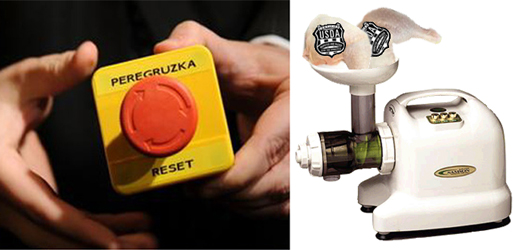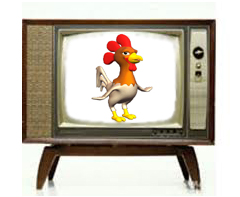
By John Helmer in Moscow
When US Secretary of State Hillary Clinton presided at the original button ceremony in Geneva on March 6, 2009, on the button she presented Foreign Minister Sergei Lavrov was written the word, in Latin letters, PEREGRUZKA. In Russian, that doesn’t mean RESET, as much of the subsequent reporting of the button has suggested. What the button originally meant was OVERLOAD.
What Clinton was trying for was PEREZAGRUZKA. And Lavrov explained the difference at the time. “I would like to present you,”Clinton said, “with a little gift that represents what President Obama, Vice President Biden and I have been saying. We want to reset our relationship, and so we will do it together. We worked hard to get the right Russian word. Do you think we got it?” Lavrov replied: “You got it wrong,” adding that the word he was looking at meant “overcharge,” though “overload” might be more precise. “We won’t let you do that to us,” Clinton replied.
This time it’s the Russian turn to press the wrong button — or is PEREGRUZKA the right one when it comes to the Russo-American chicken trade?
Since the start of this year, Russian sanitary restrictions on chlorine processing of poultry and allowable chlorine limits have barred almost all US imports. The dispute over chlorine as a health hazard had started a year ago; the import halt on January 1. Then between March and May of this year, negotiators for the two sides reached an agreement on technical substitutes for chlorine processing to allow resumption of trade.
This was officially announced during the meeting in Washington, DC, last month between Presidents Dmitry Medvedev and Barack Obama. At the joint news conference on June 25, Obama said: “It’s odd, when you’re sitting in historic meetings with your Russian counterpart, to spend time talking about chicken. But our ability to get resolved a trade dispute around poultry–that is a multibillion-dollar export for the United States–was an indication of the seriousness with which President Medvedev and his team take all of these trade and commercial issues.”
Medvedev did not address the chicken trade issue. He did claim that the hamburger which he had been invited to eat by Obama at a fast-food outlet was “not quite healthy, but it is very tasty.”
On the Russian chicken ban, Obama had earlier come under pressure from American poultry producers and their Senate and Congressional representatives; the latter had sent a letter to the White House on June 23, arguing the ban on US poultry was not so much dictated by protectionism for the Russian poultry industry, as a plain case of anti-Americanism.
“The current ban seems arbitrary and capricious,” the letter ran. “Science has shown the use of chlorine solutions to be a safe and cost-effective way to maintain food safety during poultry processing. We understand Russia is still buying poultry from other suppliers, such as Brazil, where some facilities use the same process as those in the United States, without guarantees that they are not using chlorine solutions. This disparity appears to be contrary to the Russian government’s assertion that its actions are being taken out of concern for the safety of its population. The cumulative effect of the actions taken by Russia’s government has been to keep U.S. products entirely out of the Russian market.”
US industry sources said after the June 25 announcement of the resumption of trade that they were still unclear what would happen to their Russian import quota for this year of 600,000 tonnes.
Yesterday, Medvedev provided his answer during a meeting with farm and food industry policymakers at a village in the Belgorod region. According to the press reports, Medvedev claimed the unused portion of the US poultry quota for this year should be cancelled, since “this is the normal practice.”
The official Kremlin transcript of Medvedev’s speech did not include this remark. US officials say the meaning of the president’s remark on the quota issue is ambiguous. They decline to comment publicly.
One interpretation of Medvedev’s statement, the US poultry exporters acknowledge, is that the Kremlin means to cut the US quota for poultry sales to Russia in the remainder of this year by half – to 300,000 tonnes. Estimates of how much export income would be lost range around $300 million.
US industry sources also estimate that up to 150,000 tonnes of the original US quota may been allocated to other countries, and may already have been traded by Russian importers. That would suggest, according to these sources, that the US has up to 450,000 tonnes of chicken still to trade before December 31.
The principal Russian producer of chicken hopes this number will be closer to 300,000 than 450,000. Irina Ostryakova, spokesman for the Cherkizovo group, told Fairplay: “I cannot tell you exactly how much the US will lose, because shipments have been resumed not too long ago, and it’s difficult to give a forecast yet. Usually the bigger part of poultry imports from the US arrives in the second half of the year. But it is clear that they will not be able to import the 600,000 tonnes they planned. The Russian side still has to check the quality of the newly arriving poultry and give their verdict.”
According to Cherkizovo, “we agree with President Medvedev’s suggestion that the unused quota should be reduced. Currently, the Russian manufacturers accelerate production and will be able to compensate for the loss of imports.”
Officially, what will happen next is that a recommendation to reduce the quota for US poultry will be reviewed by the Ministry of Trade, and a recommendation then prepared for the government. If approved, an order cutting the quota for the rest of the year would then be signed by Prime Minister Vladimir Putin. Yesterday’s statement by Medvedev appears to be the green light for the Trade Ministry, but officials there are not responding.
Medvedev’s speech yesterday went much further than making an apparent cut in imports of US poultry over the next few months. For Medvedev set out a food production strategy which envisages, not only substitution for US poultry imports by domestic producers, but an attack on US exports to third-country markets, where Russian poultry and other meats should in time, according to Medvedev, be able to compete, just as Russian wheat is already capable of doing.
“We predicted”, said Medvedev, “a significant increase in meat consumption in the world, mostly poultry and pork. Russia has regularly supplied meat to countries such as China and Vietnam. According to the results of 2009, as I understand it, [Russian exports of poultry and pork] were about 10,000 tonnes. While a small amount, that is something for us to start with. For Russia, the opportunity in this case is the potential to become a solid player in the international food market. Therefore, we should engage in balancing the situation inside the country and our export capacity, because without exports, we can not create a fully working livestock. We need to do everything necessary to achieve this strategic goal: to create financial mechanisms, infrastructure and legal framework, while, of course, taking into account our obligations under international associations.”
This is as good as dance music at Cherkizovo, owned by Igor Babaev, Sergei Mikhailov and their families, the dominant producers of poultry in Russia.

Operating and financial results for Cherkizovo for the first quarter, issued on May 26, reveal how lucrative the absence of US poultry has turned out to be for the profit line on the group’s balance-sheet. Sale revenues were $268 million, up 29% on the first quarter of 2009. Earnings (Ebitda) jumped 28% to $48.1 million; and net income jumped 33% to $31 million.
According to Sergei Mikhailov, Cherkizovo’s chief executive, “our results were affected by seasonal factors, as well as by the tighter pricing environment, in particular, in the Poultry and Pork businesses. Poultry prices reduced in the first quarter of the year due to higher inventory stocking by producers in the fourth quarter of 2009, which was driven by an increased share of imports in the second half of the year. However, towards the end of the quarter poultry and pork prices recovered strongly, and this trend has continued in the second quarter.”
Cherkizovo was able to feed demand with increasing production of its own chicken, and exploit the tightening supply condition in the market, without competing American imports, by earning higher profits on rising prices. “The Poultry division,” said Mikhailov, “started to see returns from the large-scale capacity increase projects we initiated last year…In the Poultry division we saw profitability returning to historical levels, as 2009 was characterized by unusually high pricing trends. Accordingly, we have achieved a 29% Gross Margin, and a 20% Adjusted EBITDA margin. We accelerated the pace of investment in the division; progressing on two projects at our Bryansk and Penza clusters, which are expected to increase the Group’s poultry capacity by 40% once the sites are fully operational in 2012.”











Leave a Reply